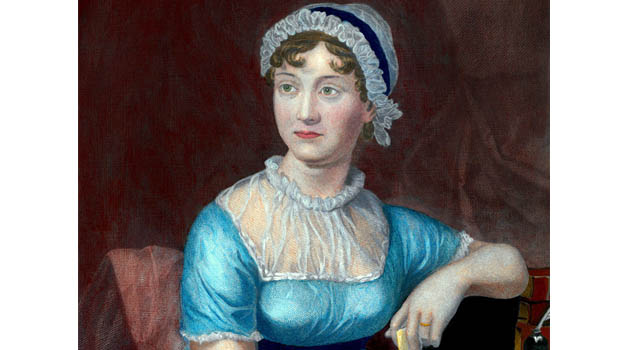Jane Austen
A romantic writer who didn’t find love

Jane Austen was born on December 16, 1775, at Steventon Rectory in Hampshire, England. Her father, Reverend George Austen (1731-1805) was the rector at Steventon. In 1764, he married Cassandra Leigh Austen (1739-1827) who was from a patrician family. Jane Austen was the youngest of George and Cassandra's eight children - she had six brothers and one sister. The family was tightly-knit, and Jane was particularly close to her sister, Cassandra, and her brother, Henry, who later, became her literary agent.
George and Cassandra Sr. sent Cassandra and Jane (who was only 8 years old at the time) to Oxford and Southampton to be educated. However, after Jane nearly died during an outbreak of typhus at their boarding school, both girls returned home to continue their studies. From 1785 to 1786, Jane and Cassandra attended the Reading Ladies Boarding School, where they studied French, spelling, needlework, music, and dancing. Economic hardships forced the girls to return home once again. Their father maintained a large library and indulged his daughters' curiosity with plenty of reading material. As a result, Jane and Cassandra continued to develop their literary talent despite their lack of a formal education.
Beginning in her teen years, Austen wrote poems, stories, and comic pieces for the amusement of her family. She compiled several of the pieces she wrote between 1787 and 1793 into three bound notebooks, which scholars now refer to as Austen’s “Juvenalia.” Austen expressed an interest in drama and comedy; she often staged theatrical productions at home with her siblings. As she continued to experiment with writing, Austen became adept at parodying the sentimental and Gothic style of eighteenth-century novels. Among Jane Austen's early works is a comic novel with the deliberately misspelled title, “Love and Freindship,” a satire of the “History of England,” and “Lady Susan," an epistolary work. During this time, Austen also began to sketch out ideas for the novel that would later become Sense and Sensibility.
In 1795, Austen met Tom Lefroy, the nephew of her neighbor at Steventon. In her letters to Cassandra, Austen wrote about spending a great deal of time with Lefroy and hinted at her romantic feelings for him. Unfortunately, a marriage between them was impractical, and LeFroy’s family soon sent him away. After the conclusion of her brief romance with Lefroy, Austen began work on a second novel called First Impressions, which would later become Pride and Prejudice. After that, Austen began to revise her initial outline for Sense and Sensibility and developed Northanger Abbey, a satire of the Gothic literary genre.
The Austen family resided at Steventon until 1801, when Reverend Austen announced his retirement from the ministry. He then moved the family to Bath. Jane was unhappy about leaving her childhood home, which resulted in a sudden decrease in her productivity. During her time at Bath, Austen only made minimal revisions to her draft of Northanger Abbey and started (but soon abandoned) a fourth novel.
While in Bath, Austen also received her only marriage proposal: from Harris Bigg-Wither, the younger brother of a family friend and an Oxford graduate who was six years Austen's junior. Bigg-Wither was supposedly unremarkable both physically and intellectually, but his considerable fortune made him an attractive bachelor. Jane Austen initially accepted his proposal, but changed her mind the following day and rescinded her promise. Turning down a marriage proposal was a significant decision for a woman during this time period, as marriage was the only way Jane would have been able to gain independence from her family. Marrying Bigg-Wither would also have allowed Jane to provide a home for her sister, Cassandra, and could even have helped Austen's brothers in their efforts to secure better careers.
After George Austen's death in 1805, Jane, her mother, and her sister had to move in with her brother Francis because of their unstable financial position. In 1809, they moved to a cottage at Chawton, where Jane's wealthy brother Edward had an estate. Life in Chawton was much quieter than it had been in Bath, which gave Jane Austen the opportunity to write more often. While living at Chawton, four of her novels were published anonymously: Sense and Sensibility in 1811, Pride and Prejudice in 1813, Mansfield Park in 1814, and Emma in 1815. In July of 1816, Austen completed the first draft of her next novel, entitled “The Elliots.” It would later be published as Persuasion.
In early 1816, Austen suffered an onset of illness that culminated in her death the following year. Most biographers believe that she suffered from Addison’s Disease. Despite her illness, Austen continued to write, revising the ending of “The Elliots” and starting work on “Sandition.” She died at the age of 41 on July 8, 1817 and was buried at the famous Winchester Cathedral. Northanger Abbey and Persuasion were published posthumously (as a set) in 1817. However, Austen was unable to finish “Sandition” before her death.
Austen’s novels mostly focus on themes of courtship and marriage. However, her work stands out because of her sharp, satirical depiction of late 18th century English society. She is still one of the most studied and influential novelists of her time, largely because she was creating strong, unusual female characters during this period (known as the Regency period), and also for her mastery of form, satire, and irony. In 1833, publisher Richard Bentley published the first collected edition of Austen’s novels. Since then, her works have been continually in print.
As with many great authors, Austen died before she gained significant public recognition. Although her novels were fashionable with prominent members of British society like Princess Charlotte, the daughter of the Prince Regent, critics largely ignored her work. In the twentieth century, Austen’s novels began to attract attention from literary scholars who conducted serious academic studies on her texts. Over the past several decades, there have been more than 200 literary adaptations of Austen’s novels, as well as numerous film versions.
-Internet



